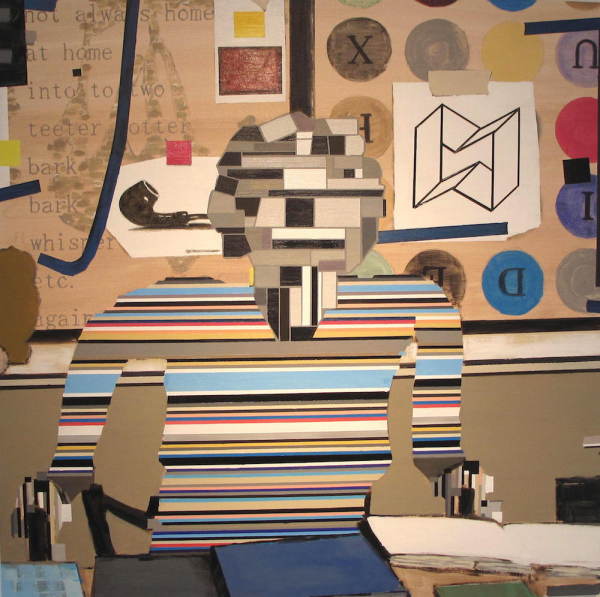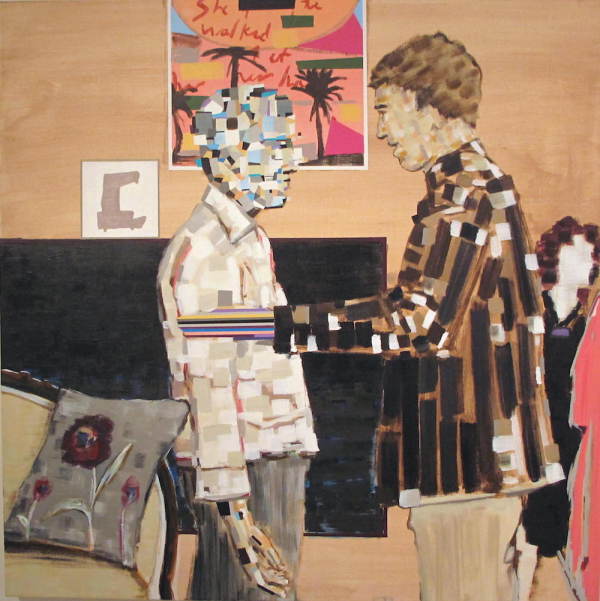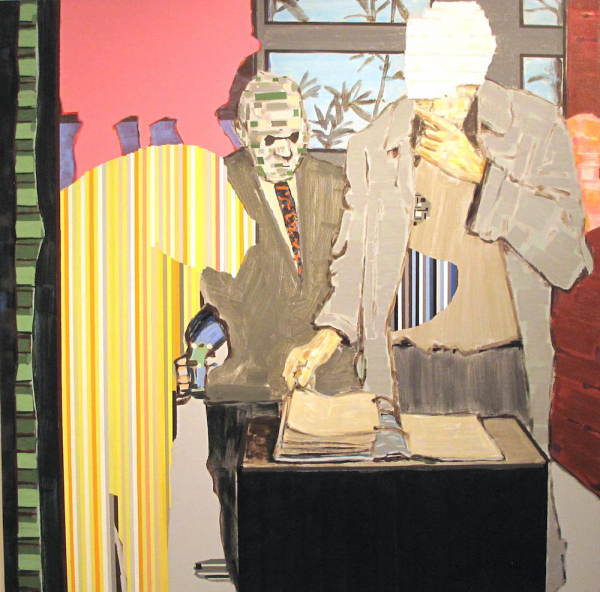At first glance, Matthew Bourbon‘s paintings in Arch Deceivers at Avis Frank Gallery in Houston may seem like self-conscious postmodern pastiche: each is a salad of jarringly contrasting painting styles, text, and virtual collage, but the mix-and-match strategy isn’t the usual riff on art history, it’s the considered choice an urbane observer of contemporary public life. Bourbon is one of those oddball figurative artists like Richard Merkin, R.B. Kitaj, or Francis Bacon who appropriate the vocabulary of modernist abstraction for expressive purposes.

Inscrutable Author
In each of Bourbon’s paintings, human figures are obscured and replaced by patches of pattern painting. Seeing a screen of stripes where one expects a face is off-putting, literally a defacement. It’s the kind of thing art students do to cover their inability to draw, or that upset critics when Cubism was still new.
But Bourbon cloaks his people in abstractions as a metaphor for their social facades, hence the title, Arch Deceivers. It’s no coincidence that the colored stripes and squares recall the pixelation used to obscure faces in anonymous video interviews. Moreover, the patterns suggest the texture of each figure’s personality. This guy is red and yellow stripes. That one is gray brickwork. In Inscrutable Author, a figure bends over a desk, working. We don’t need to read her book to know it’s dry and heady— her gray blocky head is swelling with the disjointed symbols and diagrams painted on the wall behind her.

Department of Departments
In Department of Departments three very different figures meet in front of some obscure posters. A slender brown fellow whose head is a thatch of hairy brushstrokes, a woman built from blocks of blue Jell-O, and a bulky, gray guy like a copy machine confer over some obscure policy. Bourbon focuses on the way office chats feel, when distinct personalities put their heads together in a hallway.

My Weakness is Your Weakness
Bourbon’s also a keen observer of body language. In My Weakness is Your Weakness, a man in a brown jacket reaches out to another man in a white shirt, consoling, cajoling, counseling. The reaching hand is reduced to colorful stripes because it’s the action point of the painting, the point of contact. By contrast, white shirt’s flaccid, imploring hand below is made up of disjointed blocks of color.

Bad Actors
All the paintings are interiors, little realist one-act plays set in the familiar world of offices, schools, and homes. Bourbon sets aside the operatic tradition of figurative painting, instead of romance or battle, Bourbon’s people read, sew, or confer quietly; undramatic actions that make the fabric of life in our safe middle-class society. Even Bourbon’s Bad Actors are white-collar criminals.
They’re the kind of pictures you see in corporate annual reports or school course catalogs, given a boost: the erasure of the specifics of individual identities forces us to focus attention on the nuances of these undramatic situations, and allows us to more easily enter the blank spaces Bourbon leaves in his ambiguous stories. It’s the life most of us lead, dull when compared to the turmoil and drama of traditional narrative art, yet through its truthiness, surprisingly affecting.



2 comments
Very nice piece Bill. I’m coming down next week to see it and others. Looking forward to seeing the finished works.
Very interesting! A nice analysis of the paintings with their historical context and possible narrative content!